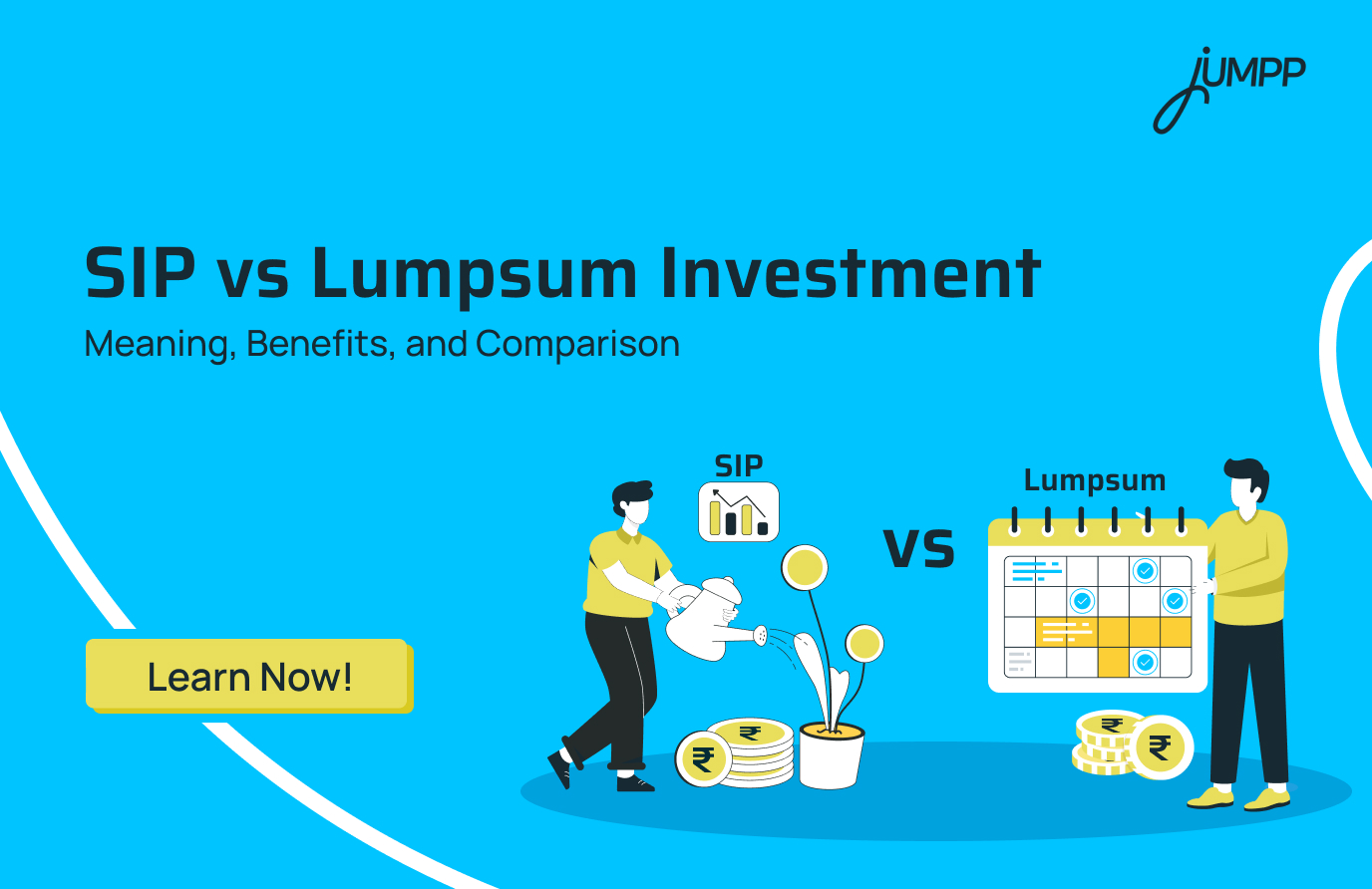SIP vs Lumpsum: Which Investment Strategy Delivers Better Returns?

The Indian mutual fund industry is expanding rapidly, with Average Assets Under Management (AAUM) reaching ₹77.78 lakh crore in September 2025. As more people begin investing through mutual funds, one question continues to confuse all. When it comes to building long-term wealth, what works better in reality: SIP vs. lumpsum?
While SIP involves investing a fixed amount regularly, a lumpsum means investing a large amount at once. Let us understand the comparison between SIP vs. lumpsum and the types of each to help you choose the right path for your financial goals.
What is Systematic Investment Plan (SIP)-
A Systematic Investment Plan (SIP) involves investing a fixed amount at regular intervals, usually monthly or quarterly, into a mutual fund.
What is Lumpsum-
A lumpsum investment means investing a large amount in one single transaction.
SIP vs Lumpsum- Key Differences
Here is the simple comparison between SIP vs Lumpsum.
| Feature | SIP (Systematic Investment Plan) | Lumpsum Investment |
| Investment Method | A fixed amount is invested at regular intervals, such as monthly. | A significant sum is invested at once in a single transaction. |
| Risk | Reduces market timing risk through rupee-cost averaging, which smoothens out the purchase price over time and performs well in volatile or falling markets. | Carries a higher short-term risk as returns depend on market conditions at the time of investment. |
| Returns | Benefits from compounding and consistent investment over time, often delivering comparable long-term returns to lumpsum investments. | It can offer higher returns if timed correctly during a rising market phase. |
| Discipline | Encourages financial discipline through regular, automated contributions. | Does not build the same saving habit since the investment is one-time. |
| Who Is It For? | It is ideal for salaried individuals with steady income streams and for new or risk-averse investors. | This is suitable for investors with a large surplus of funds and a higher risk tolerance. |
| Flexibility | Offers flexibility to start, pause, or stop investments as needed. | Less flexible once the entire amount is invested. |
For a balanced strategy, many investors prefer using a combination of both methods.
What is SIP in mutual funds?
SIP stands for Systematic Investment Plan. It is a method of investing in mutual funds where an investor contributes a fixed amount at regular intervals. This could be monthly, quarterly, or even weekly, but into a selected fund.
Let us understand what is SIP and how it works!
How SIP Works
Here is how an SIP works:
- Once you set up a SIP, a fixed amount is automatically deducted from your bank account and invested in a mutual fund on a specific date.
- You invest smaller, fixed amounts regularly instead of a large sum at once, reducing the impact of market volatility.
- Many mutual funds allow SIPs starting from as little as ₹100, making it easy to begin investing.
- You can choose how often to invest — monthly, quarterly, or weekly — based on your income flow and goals.
- Regular investments grow over time through compounding, helping you build wealth gradually and consistently.
What are the benefits of SIP?
The benefits of SIP extend far beyond convenience. According to AMFI, monthly SIP inflows crossed ₹20,000 crore in September 2025 (AMFI, 2025). This figure shows how and why people prefer SIP nowadays.
Here are some of the most significant advantages for investors in 2025:
1. Rupee-Cost Averaging – Markets fluctuate daily. SIP ensures that you buy more when prices are low and less when they are high. This helps in bringing down your average purchase cost over time.
2. Power of Compounding – Each month’s return adds to the next, and over years, the snowball effect becomes significant. The longer you stay invested, the greater the compounding effect.
Learn more about the power of compounding in the stock market!
3. Disciplined Investing – Since the amount is auto-deducted, it instils discipline and reduces the temptation to time markets or pause investing due to short-term fear.
4. Affordable and Flexible – You can start an SIP with as little as ₹100 per month and increase or pause it anytime.
5. Reduces Market Timing Risk – SIPs protect you from investing a large amount right before a market correction, thereby reducing entry-level risk.
Types of SIP
Different investors have different goals, risk capacities, and time horizons.
Here are the main types of SIPs and when to use them:
- Equity SIP – This SIP invests in equity mutual funds. It is suitable for long-term wealth creation (5–10 years or more). It does have a higher risk but offers a higher return potential.
- Debt SIP – This SIP invests in debt mutual funds. It is suitable for short to medium-term goals. This SIP plan offers stable, lower-risk returns.
- Hybrid SIP – Hybrid SIP invests in a mix of equity and debt funds. It balances growth with stability. This is best for moderate-risk investors.
- Index SIP – It tracks benchmark indices like Nifty 50 or Sensex. This SIP plan offers low-cost, passive investing with predictable exposure.
- ELSS SIP – Equity Linked Savings Schemes offer tax benefits under Section 80C with a three-year lock-in. They tend to combine tax planning with wealth creation.
What is a Lumpsum investment?
A lumpsum investment means investing the entire amount in one go rather than spreading it over months or years.
This approach suits investors who have a sizeable corpus and want to put it to work immediately.
In a lumpsum investment, timing plays a crucial role. If you invest just before a market correction, you might see temporary negative returns. However, if you invest during a market dip or early in a bull phase, your returns can compound much faster. That is why lumpsum investing demands more market awareness and a higher risk appetite than SIPs.
What are the benefits of lumpsum investment?
While SIPs are ideal for consistent wealth building, lumpsum investments can also be advantageous under the right conditions.
Here are the key benefits:
1. Immediate Market Exposure – Since the full amount is invested at once, you benefit from the entire market growth from day one.
2. Better Compounding Potential in Rising Markets – The longer your money stays invested, the more time compounding has to work, especially when markets trend upward.
3. Fewer Transactions – Unlike SIPs, which involve monthly installments, a lumpsum investment requires only one transaction, making it easier to track.
4. Best for Windfall or Bonus Amounts – It is ideal when you receive a large sum and wish to invest it effectively rather than leaving it idle in savings accounts.
However, this method also involves higher market-timing risk, so careful entry planning is vital.
SIP vs Lumpsum — Which Should You Choose?
Based on your financial situation, risk tolerance, and investment goals, you should choose either a Systematic Investment Plan (SIP) or a lumpsum investment, depending on what aligns best with your current circumstances. Both methods can create wealth, but their suitability varies with income stability, experience, and market conditions.
You should choose SIP if:
- You have a regular and steady income and want to build wealth gradually over the long term.
- You are a new or risk-averse investor who prefers to reduce market-timing risk through rupee-cost averaging.
- You wish to cultivate financial discipline and automate your investments each month without constantly monitoring markets.
You should choose Lumpsum if:
- You have a large amount of idle cash available that you want to invest immediately.
- You are an experienced investor with a higher risk tolerance and a clear understanding of market cycles.
- The market has recently corrected, and you believe valuations are attractive for long-term growth.
Ultimately, both SIP and lumpsum investments serve different purposes within a portfolio. Many successful investors combine the two by investing a portion of their funds as a lumpsum during market opportunities while continuing SIPs to stay consistent and disciplined.
The real key is not to time the market perfectly, but to remain invested and allow compounding to do its work over time.
Start investing with the best mutual funds app in India– multiple mutual fund schemes, a free demat account, and much more!
SIP vs Lumpsum- FAQs
Neither is universally better. SIPs reduce market risk through regular investing, while lumpsum investments can deliver higher returns if timed well in a rising market.
A ₹1,20,000 lumpsum generally grows faster due to longer compounding, while a ₹2,000 monthly SIP offers stability and spreads risk over time.
Monthly SIPs suit regular earners seeking discipline and lower volatility, whereas lumpsum investing fits those with surplus funds and higher risk tolerance.
The 7-5-3-1 rule advises a 7-year horizon, 5-category diversification, awareness of 3 investor pitfalls, and 1 annual SIP increase to harness compounding and manage risk. It is a practical, behaviour-plus-allocation framework for building long-term wealth through SIPs.
Consistent 30% annual returns are unrealistic; most long-term SIPs in equity funds generate stable annualised returns of around 10–15%.
You would need to invest about ₹1.2–₹1.3 lakh per month at a 12%- 15% annual return, which requires a high monthly commitment and strong market performance.
Source– https://www.amfiindia.com/






